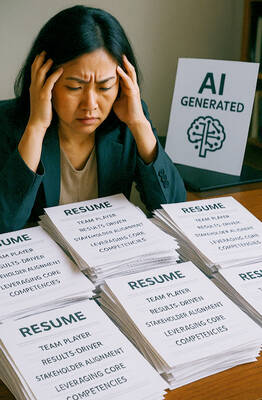These are crazy times. Biblical disturbances in nature, such as the repeated torrential rain in Dubai or the mass fish die-off in Vietnam’s overheated reservoir, seem to mirror our overheated politics and social environment.
At such moments, it is crucial to keep a cool head and analyze all the weird phenomena as closely, objectively and dispassionately as possible. Few phenomena nowadays are weirder than the protests surrounding Israel’s bombardment and invasion of Gaza in response to Hamas’ terrorist attack in October last year.
We should acknowledge the rhetoric from some politicized Muslims, such as those who recently demonstrated in Hamburg, Germany, chanting “Kalifat ist die Losung” (“Caliphate is the solution”). We should concede that, despite the massive presence of Jews among the protesters, at least a few true anti-Semites are among them (just as there are some genocidal maniacs in Israel).
While many commentators have noted the parallel between today’s pro-Palestinian demonstrations and the 1968 student protests against the Vietnam War, the Italian philosopher Franco Berardi points to an important difference. Rhetorically, at least, the 1968 protesters explicitly identified with the anti-imperialist Viet Cong position and a broader, positive socialist project, whereas today’s protesters rarely identify with Hamas, and instead are “identifying with despair.”
“Despair is the psychological and also cultural trait that explains the wide identification of young people with the Palestinians,” Berardi said. “I think that the majority of the students today are consciously or unconsciously expecting the irreversible worsening of the conditions of life, irreversible climate change, a long-lasting period of war and the looming danger of a nuclear precipitation of the conflicts that are under way in many points of the geopolitical map.”
It would be difficult to explain the situation any better than that. The authorities’ obscenely repressive response to the protests supports Berardi’s hypothesis. The harsh crackdowns are not motivated by any fear that the protests will launch a new political movement. Rather, they are expressions of panic — a futile refusal to confront the despair that pervades our societies.
Signs of this panic are everywhere, so allow me to offer just two examples. First, late last month, 12 US senators sent a letter to the International Criminal Court (ICC) threatening it with sanctions should it issue an arrest warrant for Israeli Prime Minister Binyamin Netanyahu.
Although this was strictly a Republican undertaking, US President Joe Biden’s administration has also pressured the ICC not to charge Israeli officials over war crimes committed in Gaza. Such threats signal nothing less than the demise of shared global values. Although this ideal was always somewhat hypocritical (the US, for example, has refused to join the ICC), governments at least upheld it in spirit.
The second recent example supports the same conclusion. On May 4, France (complying with a German-issued visa ban) denied entry to Ghassan Abu-Sitta, a British-Palestinian surgeon who was scheduled to provide testimony to the French Senate on what he had witnessed while treating victims of the war in Gaza. With such crude acts of censorship and marginalization happening before our eyes, it is no longer an exaggeration to say that democracies are crumbling.
Everyone knows that the situation in Gaza is unacceptable, but a great deal of energy has been devoted to postponing the kind of intervention that the crisis requires.
One way to help break the impasse is to offer public support for the student protests.
“What Netanyahu’s right-wing, extremist and racist government is doing is unprecedented in the modern history of warfare … Right now, we are looking at the possibility of mass starvation and famine in Gaza. When you make those charges, that is not anti-Semitic. That is a reality,” US Senator Bernie Sanders said on April 28.
After the attacks on Oct. 7 last year, Israel emphasized the raw realities of what Hamas had done. Let the images speak for themselves, Israeli authorities said. The brutal killings and rapes had been recorded by the perpetrators and were there for everyone to see. There was no need for complex contextualization.
Can we not now say the same about the Palestinian suffering in Gaza? Let the images speak for themselves. See the starving people in packed improvised tents, the children slowly dying as Israeli missile and drone strikes continue to reduce buildings to ruins, then to rubble and then to dust.
I am reminded of what Michael Ignatieff (then a journalist) wrote in 2003 about the US invasion of Iraq.
“For me, the key issue is what would be the best result for the Iraqi people — what is most likely to improve the human rights of 26 million Iraqis? What always drove me crazy about the opposition [to war] was that it was never about Iraq. It was a referendum on American power,” he said.
The same point does not apply to today’s anti-war protests. Far from a referendum on Palestinian, Israeli or US power, they are driven primarily by a desperate plea simply to stop the killing of Palestinians in Gaza.
So, what should the Biden administration do (aside from replacing US Vice President Kamala Harris with Taylor Swift on this year’s ticket)? For starters, the US can join the global initiative to recognize Palestine as a state. Far from being an obstacle to peace in the Middle East, Palestinian statehood is a precondition for any serious negotiations between the two sides. By contrast, rejecting (or endlessly postponing) such recognition would inevitably support the fatalistic conclusion that war is the only option.
Strange as it might sound, we are witnessing one of the downsides of the US’ loss of hegemonic power (as was also the case with the US withdrawal from northern Syria and then Afghanistan). Ideally, the US would simply invade Gaza from the sea, re-establish peace and order, and provide the population with humanitarian assistance. Do not count on it. One can always rely on the US to miss an opportunity to deploy its remaining imperial power for a good cause.
Slavoj Zizek, professor of philosophy at the European Graduate School, is international director of the Birkbeck Institute for the Humanities at the University of London and the author, most recently, of Christian Atheism: How to Be a Real Materialist.
Copyright: Project Syndicate

In an effort to fight phone scams, British mobile phone company O2 has introduced Daisy, an AI designed to engage phone con artists in time-wasting conversations. Daisy is portrayed as a kindly British granny, exploiting scammers’ tendency to target the elderly. Her voice, based on a real grandmother’s for authenticity, adds to her credibility in the role. “O2” has distributed several dedicated phone numbers online to direct scammers to Daisy instead of actual customers. When Daisy receives a call, she translates the scammers’ spoken words into text and then responds to them accordingly through a text-to-speech system. Remarkably, Daisy

Bilingual Story is a fictionalized account. 雙語故事部分內容純屬虛構。 Emma had reviewed 41 resumes that morning. While the ATS screened out 288 unqualified, she screened for AI slop. She could spot it a mile away. She muttered AI buzzwords like curses under her breath. “Team player.” “Results-driven.” “Stakeholder alignment.” “Leveraging core competencies.” Each resume reeked of AI modeling: a cemetery of cliches, tombstones of personality. AI wasn’t just changing hiring. It was draining the humanity from it. Then she found it: a plain PDF cover letter. No template. No design flourishes. The first line read: “I once tried to automate my

Every May 1, Hawaii comes alive with Lei Day, a festival celebrating the rich culture and spirit of the islands. Initiated in 1927 by the poet Don Blanding, Lei Day began as a tribute to the Hawaiian custom of making and wearing leis. The idea was quickly adopted and officially recognized as a holiday in 1929, and leis have since become a symbol of local pride and cultural preservation. In Hawaiian culture, leis are more than decorative garlands made from flowers, shells or feathers. For Hawaiians, giving a lei is as natural as saying “aloha.” It shows love and

1. 他走出門,左右看一下,就過了馬路。 ˇ He walked outside, looked left and right, and crossed the road. χ He walked outside and looked left and right, crossed the road. 註︰並列連接詞 and 在這句中連接三個述語。一般的結構是 x, y, and z。x and y and z 是加強語氣的結構,x and y, z 則不可以。 2. 他們知道自己的弱點以及如何趕上其他競爭者。 ˇ They saw where their weak points lay and how they could catch up with the other competitors. χ They saw where their weak points lay and how to catch up with the other competitors. 註:and 一般連接同等成分,結構相等的單詞、片語或子句。誤句中 and 的前面是子句,後面是不定詞片語,不能用 and 連接,必須把不定詞片語改為子句,and 前後的結構才相等。 3. 她坐上計程車,直接到機場。 ˇ She took a cab, which took her straight to the airport. ˇ She took a cab and it took her straight